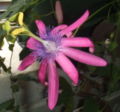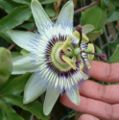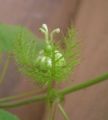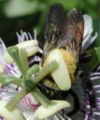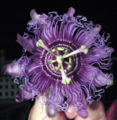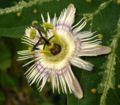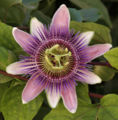Passion flower
Passiflora {{{latin_name}}}
|
Passion flower, passion vine
| ||||||||||||||||||||||||||||||||||||||||
|---|---|---|---|---|---|---|---|---|---|---|---|---|---|---|---|---|---|---|---|---|---|---|---|---|---|---|---|---|---|---|---|---|---|---|---|---|---|---|---|---|---|
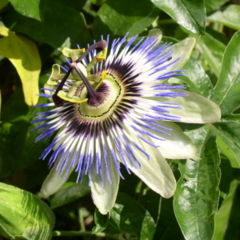
|
|
| |||||||||||||||||||||||||||||||||||||||
| |||||||||||||||||||||||||||||||||||||||||
There are approximately 500 species in the Passiflora genus, better known as Passion flowers or passion vines. The exotic flowers and fruit of many varieties are popular with gardeners. Most are vines, but some are shrubs, and a few are herbaceous. The most commonly eaten passionfruit grows on Passiflora edulis.
Fruit
Most species produce round to elongated edible fruit, though few are widely eaten. Fruit is 2-8 inches long and 1-2 inches across, depending on species or cultivar.
The passion fruit or maracujá (P. edulis) is cultivated extensively for its fruit, which is used as a source of juice. A small purple fruit which wrinkles easily and a larger shiny yellow to orange fruit are traded under this name. The yellow form is normally just treated as a variety flavicarpa, but appears to be more distinct in fact.
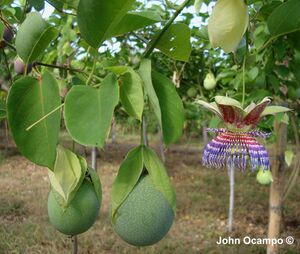
Sweet Granadilla (P. ligularis) is widely-grown. It's called "passionfruit" in much of of Africa and Australia: in South Africa it is usually called "granadilla". The fruit is something like a combination of the two P. edulis types.
Maypop (P. incarnata), is common in the SE United States. It is a subtropical, in a mostly tropical family. Unlike most of the tropical varieties, this species can withstand cold down to -4°F (-20°C) before the roots die. It has been cultivated north to Boston and Chicago. The yellowish fruit is sweet, and about the size of an egg. Grown for the edible fruit and for being relatively pest free.
Giant Granadilla (Giant Tumbo or badea, P. quadrangularis), Water Lemon (P. laurifolia) and Sweet Calabash (P. maliformis) are popular for their fruit in certain, localized parts of the world. Wild Maracuja are popular in SE Asia and are the fruit of P. foetida. Banana passionfruits grow on P. tripartita var. mollissima and P. tarminiana, and as the name implies are rather elongated. These two are eaten locally, and are very invasive.
Cultivation
| calendar? | ||
|---|---|---|
| January: | ||
| February: | ||
| March: | ||
| April: | ||
| May: | ||
| June: | ||
| July: | ||
| August: | ||
| September: | ||
| October: | ||
| November: | ||
| December: | ||
| Notes: | ||
- Do you have cultivation info on this plant? Edit this section!
Propagation
- Do you have propagation info on this plant? Edit this section!
Pests and diseases
- Do you have pest and disease info on this plant? Edit this section!
Species
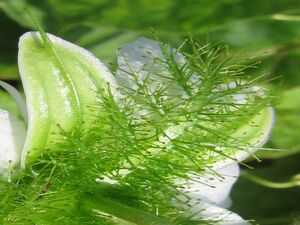
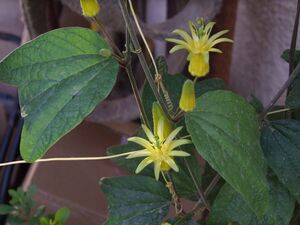

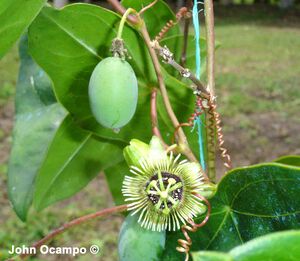
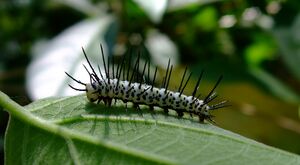
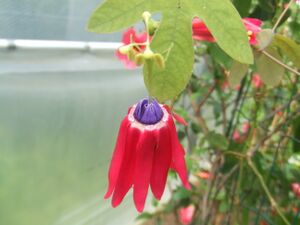

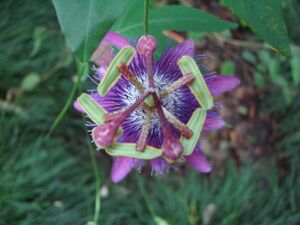
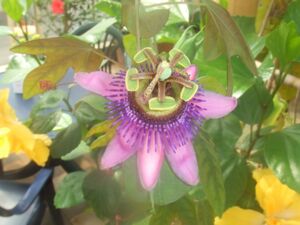
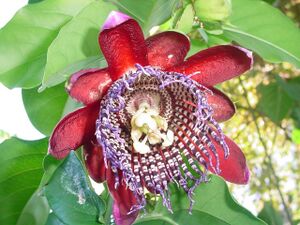
Selected species:
Gallery
If you have a photo of this plant, please upload it! Plus, there may be other photos available for you to add.
-
Passiflora kermesina
-
Passiflora caerulea with hand for comparison
-
Passiflora sanguinolenta
-
P. foetida bud
-
Passiflora incarnata pollinated by Xylocopa virginica (a carpenter bee)
-
Passiflora citrina
-
Passiflora picturata
-
Passiflora racemosa
-
Passiflora serratifolia
-
Passiflora tulae
-
Passiflora vitifolia
-
Passiflora xishuangbannaensis
-
Passiflora 'Incense' is a decorative plant
-
Passiflora xishuangbannaensis, a recently-described species
-
Passiflora pardifolia was only described in 2006
References
External links
- w:Passion flower. Some of the material on this page may be from Wikipedia, under the Creative Commons license.
- Passion flower QR Code (Size 50, 100, 200, 500)
- The Passiflora Society International
- Passiflora online
- Passiflora edulis
- Passiflora Picture Gallery
- Chilean Passiflora pictures
- A list of Heliconius Butterflies and the Passiflora species their larvae consume
